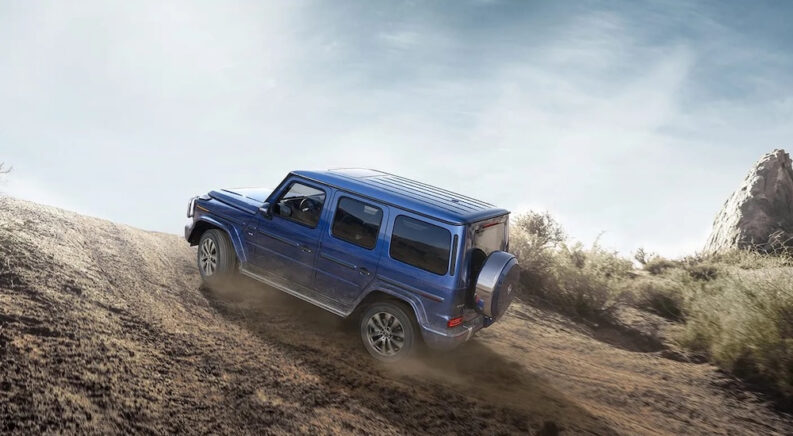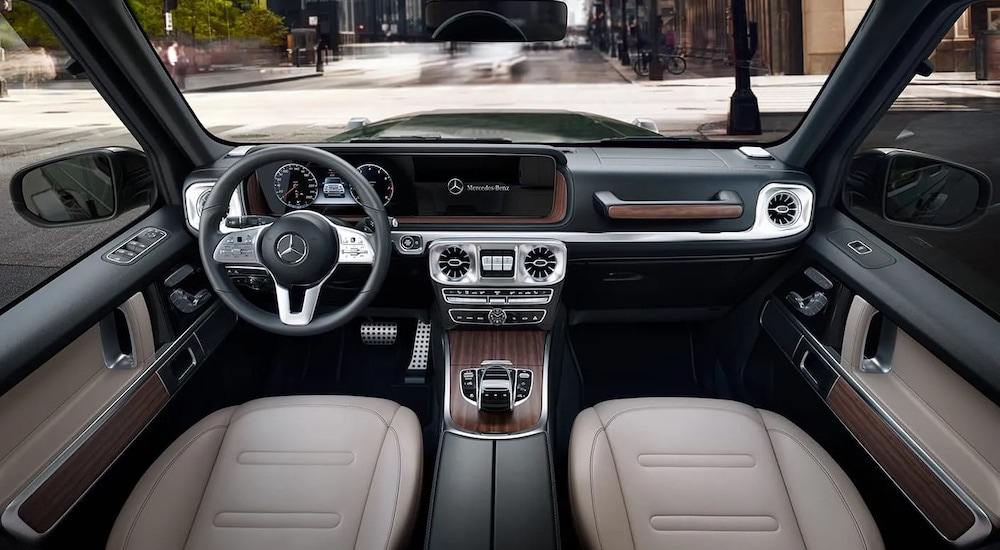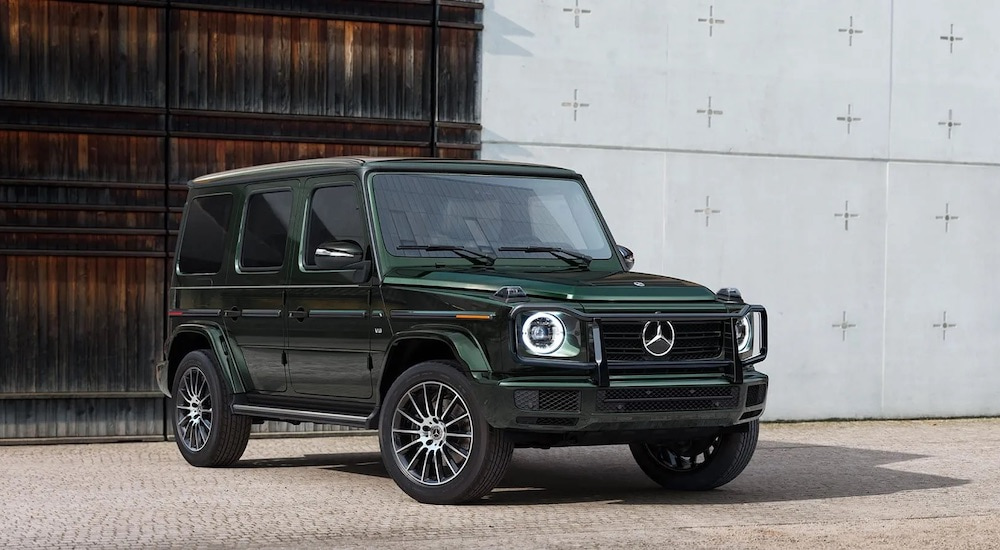When most people think of Mercedes-Benz, they picture the brand’s sleek sedans and low-slung performance models. While luxury SUVs have made their way into the automaker’s lineup in recent years, one Mercedes-Benz model stands out from the crowd with its boxy design, off-road chops, and luxuriously appointed interior. Introduced in 1979, the Mercedes-Benz G-Class, commonly known as the G-Wagon, is a decidedly different offering from the German brand. Mercedes-Benz has managed to sell more than 500,000 units since the G-Wagon was first introduced, which is certainly not a bad showing for a vehicle that starts at over $140,000. But the Mercedes-Benz G-Wagon wasn’t always the luxury icon it is today. Join us as we trace the unusual history of this storied SUV, follow its off-road achievements, and see how the G-Wagon has earned its lofty reputation amongst not only luxury buyers but various heads of state, militaries, and even a Pope.
Circling the Wagon
Most new vehicles are first conceived through intensive market research, but when one of your largest shareholders––and the sovereign leader of a Middle Eastern country––requests 20,000 off-road SUVs, the traditional development pipeline tends to go right out the window. That was the case when the Shah of Iran tasked Mercedes-Benz with crafting a four-wheel drive vehicle that could serve as both an off-road utility rig and a reliable daily driver. Aimed at both the military and civilian segments, the Mercedes-Benz Geländewagen (“cross-country vehicle”) never actually got a chance to brave the Iranian desert as the Shah was deposed in his country’s Islamic revolution in 1979.
With development already well underway, Mercedes-Benz wasn’t about to abandon the Geländewagen project. The brand teamed up with Austria-based manufacturer––and military equipment specialists––Steyr-Daimler-Puch to form a joint company called Geländefahrzeug Gesellschaft. In a bid to engineer the off-road vehicle to the highest possible standards, the team put the Geländewagen through the wringer, testing it everywhere from the Sahara and the Arctic Circle to the coalfields of Germany. The G-Wagon’s most unique test is one that’s still performed to this day: summiting a 3.5-mile route up an Austrian mountain that features grades as steep as 60 percent. Years of testing finally led to the newly christened G-Wagon entering full-scale production in 1979, with the first models ending up in the hands of the Swiss, Norwegian, and Argentinian armies along with the German police.
While no longer destined for the ranks of Iran’s armed forces, Mercedes-Benz kept the SUV’s military focus with some unique design choices that contributed to the model’s odd shape. The Geländewagen’s cubic design was perfect for heavily laden soldiers in full combat gear, allowing military personnel to pack into the SUV without having to remove their helmets. The modern G-Wagon can also serve as a light combat vehicle with the addition of body armor, machine gun mounts, and other equipment. This approach has certainly proved successful, with the G-Wagon finding its way into the military fleets of more than 40 countries since its introduction.
Holy Roller
The first-generation G-Wagon, which was dubbed the W460, was introduced in three distinct formats: a two-door convertible, a two-door wagon, and a four-door wagon. The G-Wagon was separated into dedicated military and civilian-focused models soon after its introduction, with both trading on their off-road dominance and reliability. That reliability has been recounted in countless adventure tales over the years, but there is one particular that stands out from the rest.
When ex-pilot Gunther Holtorf hit the road in his G-Wagon in 1990, few could have predicted just how far his travels would take him. Riding in his trusty 1988 model, Holtorf covered some 560,000 miles over the course of the next 25 years. Holtorf traveled through some of the world’s most difficult and hostile terrain, including trips through traditionally off-limits countries like Cuba and North Korea. The adventurer’s trusty G-Wagon would cross through 215 countries by the time all was said and done, which is particularly impressive when you consider that, aside from some reinforced springs and shock absorbers, the vehicle was entirely stock. Holtorf also saw the G-Wagon’s gross vehicle weight rating as more of a suggestion than a red line, regularly overloading the SUV by as much as 1,100 lbs with emergency supplies, rations, and spare parts. The engine, axle, and transmission all survived the decades-long journey and earned his G-Wagon a place in the Mercedes-Benz Museum in Stuttgart, Germany.
Holtorf was certainly blessed throughout his years of traveling, but few drivers can claim quite the same degree of divine backing as one of the G-Wagon’s most famous owners: Pope John Paul II. Designed for the Pope’s 1980 visit to Germany, Mercedes-Benz made some substantial changes in order to improve safety and visibility. Engineers replaced the backseat with a raised platform that allowed for standing, wrapped it in a transparent dome, and gave the vehicle an all-white paint job to match the Pope’s traditional vestments. The original four-cylinder, 102 hp model was replaced by a brawnier 125 hp 230 GE model in 1982. The G-Wagon would continue to serve as the official Popemobile for two decades, though you’d have been wise not to use the term around the man himself. In the early 2000s, Pope John Paul II asked the media to stop calling his personal vehicle the Popemobile, calling the word “undignified.”
The G-Wagon wasn’t the first vehicle to be called the Popemobile––that honor would go to a truck from Polish automaker FSC Star, which was used when Pope John Paul II visited his home country in 1979––but it does join a short list of models that have been deemed fit to convey the Catholic Church’s supreme pontiff. The brand’s history of supplying vehicles to the Pope actually precedes the modern incarnation of the Popemobile by more than 40 years; A Mercedes Nürburg 460 was used by Pope Pius XI in 1930 and was later replaced by a Mercedes 300 Landaulet in 1960. The original G-Wagon version of the Popemobile currently resides at the Mercedes-Benz Museum, where it’s regularly put on display.
A New Focus on Luxury
The 1990s brought a lot of changes to the G-Wagon. While the SUV had built an iron-clad reputation for off-road performance in its first decade, Mercedes decided to widen the model’s appeal by giving it the full luxury treatment. The G-Wagon was just as boxy as ever on the outside, but opulent additions like wood trim, leather seats, and cruise control gave the interior a thoroughly modern makeover that made it a fast favorite amongst luxury buyers. Mercedes added some other features to improve the G-Wagon’s practicality, outfitting the off-roader with anti-lock brakes, stability control, and running boards that made entering and exiting the towering SUV just a little less of a hassle.
The G-Wagon wasn’t initially available in the United States (aside from some “gray market” imports), but that all changed in 1993 when Santa Fe-based company Europa made a deal to import the model. Getting the hulking G-Wagon past American authorities was no easy task, requiring some redesigns and upgrades that had a big impact on the SUV’s price tag. The G-Wagon was finally here, but it wasn’t cheap, and that exclusivity created an immediate aura of luxury that’s served the model well in the decades since. Mercedes would finally take North American distribution into its own hands in 2001, offering a V8 version of the G-Wagon for domestic drivers.
The G-Wagon has continued to evolve with the times, but these changes haven’t always proved successful. In 2007, Mercedes unveiled the new GL-Class, a unibody-based version of the G-Wagon that axed the original’s robust body-on-frame construction. The GL-Class was designed to replace the aging G-Wagon, but drivers didn’t show the same enthusiasm for the new three-row luxury model due to its questionable off-road chops.
The G-Wagon’s body-on-frame construction provides the ideal base for the sort of rugged use the SUV was designed for. While the new unibody approach certainly has its advantages when it comes to comfort and efficiency, there’s no substitute for traditional body-on-frame construction when you’re eying some off-road adventure. This largely comes down to the fact that the body-on-frame chassis can withstand a lot more abuse than unibody designs, resisting the flexing that can come with heavy-duty use.
Midlife Makeover
After almost 40 years on the market, the G-Wagon was getting a little long in the tooth. The GL-Class had failed to supplant the original, so Mercedes simply caved to consumer demands and gave the G-Wagon its first thorough makeover in nearly half a century. The W463 might bear a striking resemblance to its predecessor, but the shared equipment is limited to the SUV’s door handles and spare tire cover. Mercedes created a longer, wider wheelbase for the G-Wagon and upped the model’s already considerable luxury factor to create an all-new version that still retained all the charm drivers had come to love.
The W463’s new size and luxury focus did nothing to detract from its performance resume. The SUV’s G Professional Package adds a host of off-road-ready upgrades like a front brush guard, knobby off-road tires, and mud flaps, but it’s the Mercedes-AMG G-Wagon that really takes the model’s performance to the next level. The automaker’s performance-focused sub-brand has graced the G-Wagon with a rubber-burning makeover that allows the SUV to hit 149 mph and post a zero to 60 mph time of 4.5 seconds: not bad for a vehicle that tips the scales at nearly three tons.
Until 2024, Mercedes offered two versions of the G-Wagon: the W463 and the newer W464. The differences between the two models are largely cosmetic, although the W464 did trade in the W463’s independent front suspension for a solid axle design. Mercedes also added new LED headlights and a front grille, upgraded the interior technology, and mildly smoothed out the G-Wagon’s boxy design for the W464 in an effort to create a more aerodynamic and modern SUV.
These changes aside, it’s the addition of a new hybrid engine and all-electric version that represent the G-Wagon’s most significant upgrades. The 2025 G-Wagon now comes standard with a 443 hp 3.0-liter engine mated to a 48-volt hybrid system that improves both performance and efficiency. Debuting for the 2025 model year, the Mercedes-Benz G-Class EV swaps the hybrid powertrain for an all-electric setup that certainly doesn’t skimp on power. With an electric motor for each wheel, the EV can churn out 579 hp and 859 lb-ft of torque for a zero to 60 mph time of 4.6 seconds.
The new EV not only honors its predecessor’s reputation for off-road performance, it improves on it with a new G-Turn feature that allows the SUV to spin 360 degrees with ease. Mercedes has also introduced a new system called G-Steering that can direct different levels of power to each electric motor to help reduce the vehicle’s turning radius. Add torque vectoring, virtual differential locks, and an off-road crawl function, and you’ve got an EV that can hold its own in the off-road segment.
A Truly Unique Vehicle
The G-Wagon is one of the most unique models on the market, and it’s not hard to see why. From its military origins to its globe-trotting adventures and unsurpassed luxury, the G-Wagon has certainly made a lot of history in its 45 years on the market. While G-Wagon’s success can be largely credited to its unique fusion of luxury and off-road performance, it’s the vehicle’s role as a status symbol that’s kept it relevant for so many years. There’s no mistaking the boxy model for anything but a G-Wagon, which makes it a valuable addition to the collection of any athlete, celebrity, or musician who’s looking to up their clout. The fact that the SUV really only has one direct competitor in the Range Rover certainly doesn’t hurt, but Land Rover’s offering certainly can’t match the G-Wagon’s reputation when it comes to one of the most important metrics for any vehicle: how many Popes it’s transported.






